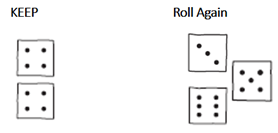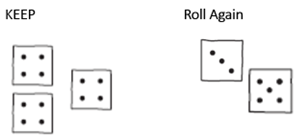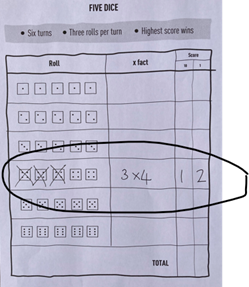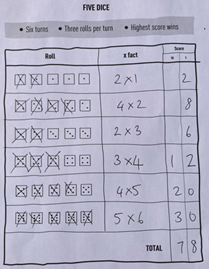Rules of Five Dice – Download the score sheet here.
Reasons to play
I love this game. So do kids. It’s fun, simple and it practises so many basic maths skills. But best of all, it gets kids using the language of multiplication in a fun and meaningful context. They use the language of unitizing all through the game, for example, “I got five fours!” and the game provides motivation to get good at skip counting and to retain multiplication facts.
This game helps children to:
- Subitise – reading dice scores
- Unitise – “I’ve got three fives!”
- Partition – writing scores
- Add – column addition for adding scores, and efficient addition strategies as six addends
- Skip count – used to work out scores quickly without counting dots
- Learn some multiplication facts – if played regularly, children see the benefit of knowing multiplication facts and they can see the meaning of those facts too.
Aim of the game: to get the most points at the end of six turns each.
Ideally play in pairs or in a group of 3. If you have a larger group, students spend too much time watching and not enough time doing maths.
How to play
Each player gets six turns. Each turn is a maximum of three rolls.
Each turn, the player collects a chosen dice score. Players can collect dice scores in any order.
Example
Player 1 rolls all five dice. They look at the scores and decide to collect fours. They keep the two dice showing four and roll the other three dice again.

On their second roll, Player 1 rolls another four. They keep this four and roll the other two dice one more time.

This time they get no more fours. They have had three rolls so their turn is over, and they record their score as 3 x 4 = 12.

Note that on the score card, they show what they rolled by marking the dice images. This means that their work can be reviewed for understanding.
When Player 1’s first turn is over, Player 2 rolls.
 When each player has had six turns and has a scored for each dice score, players add up their scores. Highest score wins.
When each player has had six turns and has a scored for each dice score, players add up their scores. Highest score wins.
Make the game more challenging!
Children needing more challenge can play the game, but they can be told that the value of the dot has changed. You can set the value of a dot to any number, but my favourites are
- Dot = 10
- Dot = 0.1
- Dot = 2
- Dot = 0.5
If you are changing the value of the dot, then ask children to record their scores on whiteboards, as the place value columns will no longer be appropriate.
Enjoy!
